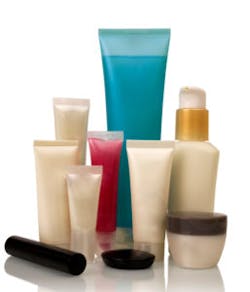Masses of large waste plastics floating in the oceans have been an issue of concern for many years. More recently, microplastic particles have been detected in seawater, freshwaters and drinking waters, including bottled waters and foods. Environmental plastics are a risk to aquatic organisms from ingestion; they are unsightly and indicative of gross mismanagement of disposal of plastic wastes. Plastics degrade very slowly over many years, and eventually produce microparticles generally roughly in the size range of about 1 to 10 µm (micrometer or micron, 1/1,000,000 of a meter) to perhaps as large as 5 mm (millimeter, 1/1,000 of a meter). Particles smaller than 1 µm could be called nanoparticles. Microplastic particles in surface freshwaters and especially treated drinking waters tend to be in the smaller size ranges (considerably less than 100 µm).
Apart from larger sea animals mistakenly ingesting large pieces, fish flesh has been found to contain plastic particles and filter feeders like clams and oysters can accumulate plastic microparticles. Studies of shellfish reported 10 microparticles per gram in some shellfish. Filter feeders are known to accumulateCryptosporidiumoocysts (4 to 6 microns), bacteria and viruses. Human food exposures are likely dominated by fish and shellfish and some plant products.
Adverse human health effects from ingestion of plastic microparticles have not yet been demonstrated. Concerns have been raised about ingestion of the microparticles, leaching of unreacted monomers into the environment or after ingestion, ingestion of absorbed trace organic chemicals from the water, and even colonization of microbes on biofilms that might form on the microparticles. Several of these are probably not real or unusual particulate-related concerns, but they do stimulate research grant applications for studies, so there will be many more publications and visibility on the topic.
What are plastics?
Plastics are synthetic chemicals made by linking together many small chemicals (monomers) to produce very high molecular weight polymers, averaging perhaps 5,000 or more linked monomers. There are many natural polymers like proteins, natural rubber, fibers and cellulose, but they are not usually included in the particles of current interest. Some examples include polyethylene, polypropylene, polystyrene, epoxys, polycarbonates, polyesters, polyamides (nylon), polyacrylates, polyurethanes, polyvinyl chloride, and elastomers like polyisoprene (synthetic rubber). The corresponding reactive monomers, respectively, include: ethylene, propylene, styrene, bisphenol A and phosgene, diacids and glycols (dialcohols), some amides like caprolactam, acrylates, diisocyanates, vinyl chloride, and isoprene. The plastics almost always contain additives like antioxidants for protection from oxygen degradation and plasticizers for maintaining flexibility. Solar UV and thermal fragmentation produce more brittleness from environmental aging, contributing to extractive loss of plasticizers that would make them more likely to degrade to particulates.
Analyses of microplastics
The analytics for microparticles in water is a formidable challenge; standard sampling and analytical methods have not yet been established. The published numbers that one sees (10 or 100, or 1,000 per liter) may seem large, but the masses involved are very small, sometimes nanograms or less. Size and dimensions of the microparticles vary and the data are driven by the type of filtration process used for sample collection and processing. Surface water samplers are commonly trawl screens with larger mesh (typically 300 µm), so the collected particles and fibers tend to be on the larger scale. Microfiltration processes are applied to other types of water.
The first challenge is to separate the microparticles from the water, then distinguish the microplastics from the usually much larger amounts (perhaps 1,000 times) of inorganic and organic natural and other particles that will also accumulate in the separation process. These can include algae, microorganisms, colloids, suspended particulates, natural fibers and others. Then the challenge is to determine the chemical identities of the mix of small particles of different sizes and chemical compositions. One recent detailed objective evaluation of more than 50 published analysis reports of water contamination by Koelmans et al.1, concluded that 46 of the studies could not be considered fully reliable because of one or more deficiencies in sample processing, lack of controls, chemical identification problems and several other criteria.
Freshwater and other contamination sources and quantities
The principal sources of plastic microparticles entering surface freshwaters are wastewater treatment plant discharges, and possibly combined sewer overflows, surface runoff, agricultural runoff where sewage sludge has been applied to the land and air deposition. Wet and dry atmospheric particle and fiber suspension and deposition can occur from tire wear, fibers from textiles and other releases. Indoor air may contain more particles and fibers than outdoor air. Estimated plastic particle amounts reported in freshwater in several world locations range from about 1 to 12 per liter. Most U.S. averages were less than 1 particle per liter with some exceptions.
Efficacy of water treatment
Depending upon surface charges or biofilms and aggregations, plastic microparticles should be susceptible to standard particle removal water treatment technologies. An early study demonstrated the capabilities of water treatment and conventional filtration to significantly reduce numbers and sizes of all types of particles in treated water. That analysis compared total (not specifically plastics) particle sizes and concentrations in a variety of waters from a river to secondary sewage effluent, to conventionally treated drinking water (Trussell and Tate, 1979). They showed that both particle numbers and sizes were distributed almost linearly from small to large, and were significantly reduced by standard water treatment. The secondary effluent ranged from about 1,000 particles/mL at about 2.5 µm, to 10 particles/mL at about 150 µm; treated drinking water was at about 5 particles/mL at 2.5 µm to less than 0.05 particles/mL at 50 µm.
PKM1/iStock
Industrial wastewater treatment
The primary control technologies are similar to municipal wastewater and drinking water technologies based upon size exclusion filtration. Conventional filtration (coagulation, flocculation, sedimentation, filtration) and direct filtration treatment, as well as membranes, will be effective. Membrane technologies would most likely include microfiltration (MF) because the nominal pore size of MF systems is 0.1 to 1 microns. Other membrane systems like ultrafiltration would be excessively stringent, less efficient and more costly. Membranes would likely be preceded by pretreatments to remove components that would accelerate fouling.
Industrial sources can include some polymer product producers, commercial abrasives and fibers manufacturers, and products containing cosmetic microbeads, which contain microplastics as abrasives. The latter are being phased out. The Organic Chemicals, Plastics and Synthetic Fibers (OCPSF) Effluent Guidelines and Standards (40 CFR Part 414)2 includes plastics and fibers industries, but as yet not the discharges of particles and fibers. The last update was in 1993.
Municipal wastewater treatment
The thousands of publically owned treatment works (POTWs) in the U.S. are required to use at least secondary treatment prior to discharge to waterways. Secondary treatment is primarily biological oxidation following primary solids removal, sometimes assisted by coagulants. The minimum performance requirement is at least 85% removal and 30 mg/L biochemical oxygen demand (BOD), and 30 mg/L suspended solids. Some plants add tertiary treatment steps like disinfection or filtration. Some particulate removal will occur and the particles would be mainly concentrated in the sludge. Thus, without more significant filtration of effluent, a substantial portion of the microparticles in the secondary treated sewage will be discharged to surface waters.
Drinking water and bottled water treatment
Since drinking waters in the U.S. derived from surface sources are virtually all treated to low turbidity (<0.3 ntu) by at least direct filtration, membranes or, most commonly, conventional filtration, tap waters would be in the low range of particle sizes and concentrations.
Bottled waters have been found to contain plastic microparticles often at levels greater than tap waters. This seems counterintuitive since processed bottled waters are often treated by reverse osmosis or other membranes. Plastic containers are produced on-site. It appears that the main source may be the on-site production of caps by routing that would likely produce small particles that can enter the water.
Conclusion
The relatively low tap water contamination by microparticles occurs from incomplete removal from surface water sources that may be contaminated by waste discharges from manufacturing facilities that utilize or produce microparticles, waste discharges to surface waters from POTWs and incomplete removal by municipal drinking water treatment plants. Bottled water is a surprising source of plastic particulate consumption, probably associated with the cap production process.
Water treatment processes including conventional coagulation, flocculation, sedimentation, filtration and membranes are very effective at removing particulates of about 1 µm and larger. The target drinking water turbidity requirement of 0.3 ntu ensures effective removal of all types of particulates. Treated drinking water concentrations of microplastics in the U.S. are typically in the less than 10 per liter. Surface drinking water is almost universally filtered. Wastewaters are often coagulated and settled or filtered, but filtration processes are not designed to remove microparticles. Improved filtration of wastewaters would reduce the presence of plastic microparticles in drinking water sources.
For perspective, the Maximum Contaminant Level (MCL) for asbestos microparticles in drinking water is 7,000,000 fibers per liter longer than 10 µm. Ingested plastic microparticles have not yet been shown to produce adverse human health effects. If there are health risks from plastic microparticles, they are more likely associated with inhalation rather than from ingestion, as with asbestos, cotton dust, mineral particles and fibers and coal dust. The World Health Organization (WHO) report issued on August 22, 2019 concluded that there were no known risks at levels found in drinking water. It recommended more study.
References
- https://www.sciencedirect.com/science/article/pii/S0043135419301794
- https://www.ecfr.gov/cgi-bin/text-idx?SID=f99261012b42322488d53a6e7911eeb9&mc=true&node=pt40.31.414&rgn=div5




